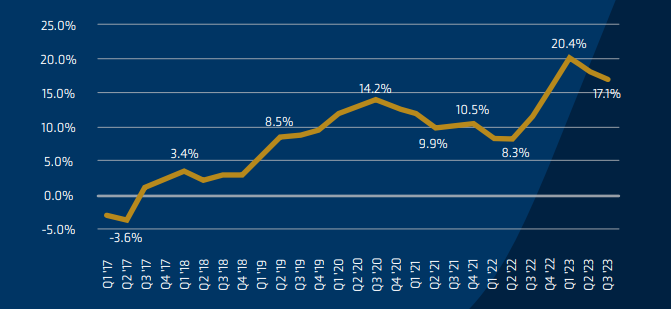Property & CasualtyInsurance Pricing & Market Update
Q4 2023
The global business landscape has undergone significant transformations in the wake of the COVID-19 pandemic. Supply chain disruptions, a direct consequence of the pandemic, have fueled a rapid two-year surge in U.S. inflation. This surge, in turn, has elevated input costs for goods production and heightened public expectations of future price increases.
Within the auto industry, persistent challenges stem from uncertain weather events and evolving mandates related to electric vehicles (EVs), creating ongoing hurdles for the sector.1
Concurrently, international conflicts and threats have intensified in various regions, posing sustained concerns. China, grappling with an economic slowdown, faces challenges marked by weakened activity and stress in specific markets, potentially impacting the global economy.2 Projections suggest that China’s GDP may only surpass that of the U.S. around mid-2040.3
The U.S. Infrastructure Bill has introduced an element of uncertainty regarding its passage and potential implications for government funding. Simultaneously, the U.S. grapples with a labor shortage, posing a significant challenge for companies aiming for growth as talent shortages persist.
Businesses are increasingly turning to artificial intelligence (AI) to enhance operational efficiency and establish effective policies. However, the rise of AI, technology, and digital advancements also brings about heightened cyber risks, necessitating robust cybersecurity measures.
In this complex and multifaceted business landscape, a thorough analysis and adaptive strategies are essential to navigate challenges and capitalize on emerging opportunities.
With business increasingly turning to AI, cyber risks are heightening.
Convective storms continue to impact values and are a crucial contributor to difficulties in coverage lines.

| Non-CAT-exposed property with favorable loss history | 17% to 30% increases |
| CAT exposed property with favorable loss history | 30% to 50% increases |
| Property with unfavorable loss history and a lack of demonstrated commitment to risk improvement | 15%+ increases for non-CAT 20% to 60% increases for CAT-exposed accounts and higher depending on frequency/severity of losses |
General Liability
| General Liability | Up 4% to 20% |
| Umbrella & Excess Liability – Middle Market | Up 7% to 20%+ |
| Umbrella & Excess Liability – Risk Management and other Complex/ Hazardous Exposures | Up 25% to 150% |
Excess Liability
Workers’ Compensation
Auto
| Workers’ Compensation | Flat to 9% |
| Auto | Up 8% to 30% Up 30%+ if large fleet and/or poor loss history |
Construction, manufacturing, and small businesses are poised to feel the most substantial impact during an economic slowdown or recession.
Directors & Officers
Cyber
| Cyber | Flat to 15% |
The parents of the deceased sued a trucking company and the vehicle operators for negligent operation of a vehicle and inadequate driver training after a van struck a tractortrailer. As it backed into a driveway, the tractor-trailer blocked the road, causing the fatal collision. The jury found that the tractor-trailer driver was acting within the scope of his employment and was responsible for 65% of the incident, with the trucking company and company owner bearing 20% and 10% of the responsibility, respectively. Consequently, the $260M verdict was lowered to $247M.8
The plaintiffs, who had previously gone to or worked at a school where the light fixtures contained Polychlorinated Biphenyls (PCBs), were granted an $82M award by the jury after filing a lawsuit against the school claiming that their exposure to the PCBs had caused them harm.9

Partner with your broker early to prepare for any changes to increase greater renewal success.
It is important to work with your broker’s industry experts who understand the business and the market for placing the specific risk. Collaborating with a team that can best represent your risk and partner with your operations is more critical than ever in this disciplined market we are experiencing.
IMA has a team solely dedicated to managing cyber risks. They offer expert assistance, including coverage analysis, financial loss exposure benchmarking, contract language review, in-depth cyber threat analysis, and strategic development of comprehensive, high- value cyber insurance programs.
Our contract review teams add value to our clients’ overall risk management program by ensuring the indemnity language is market standard and doesn’t expose our clients to unforeseen losses that may not be insurable.
Jason Patchen
SVP, National Director of Carrier Relationships
Margie Yamat
Corporate Marketing Manager Carrier Relations
Angela Thompson
Sr. Marketing Specialist, Market Intelligence & Insights
Soraya Marashi
Communications Specialist, Copy Editor
Justin Leinwand
Product Leader, Executive Risk Solution